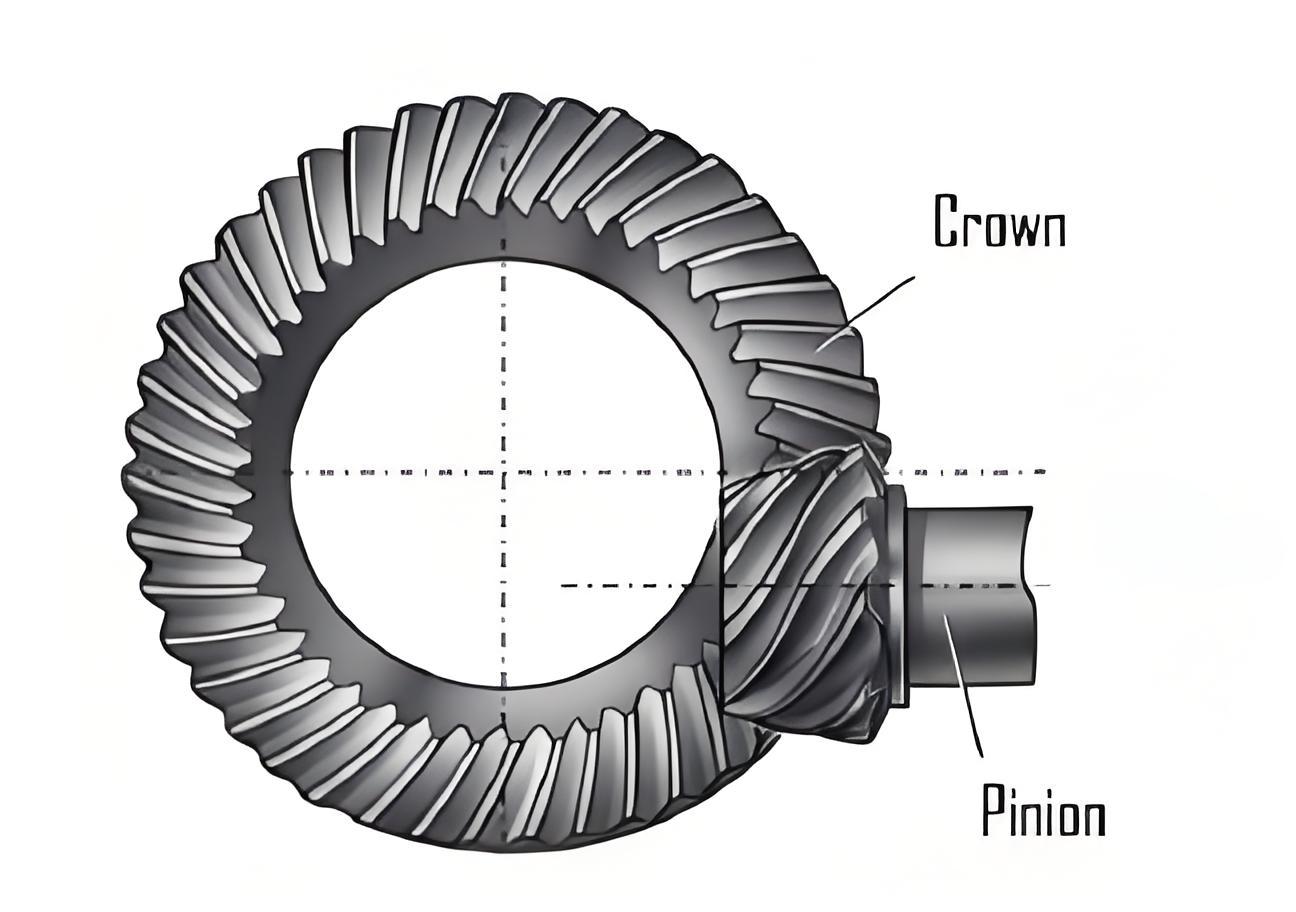Hypoid gears are critical components in automotive drive axles, transmitting torque between non-parallel shafts while accommodating spatial constraints. Their complex tooth geometry and meshing behavior introduce unique vibration characteristics that directly impact vehicle NVH (Noise, Vibration, and Harshness) performance. This paper systematically investigates the dynamic response of hypoid gear transmission systems through theoretical modeling, numerical simulation, and experimental validation.

1. Key Excitation Factors in Hypoid Gear Systems
The dynamic behavior of hypoid gear transmissions is governed by three primary internal excitations:
1.1 Time-Varying Mesh Stiffness
The periodic engagement of hypoid gear teeth creates alternating stiffness variations described by:
$$k_m(t) = k_0 + \sum_{n=1}^\infty [a_n \cos(n\omega_m t) + b_n \sin(n\omega_m t)]$$
where $k_0$ represents the average mesh stiffness and $\omega_m$ is the meshing frequency. The Fourier coefficients $a_n$ and $b_n$ are determined through loaded tooth contact analysis (LTCA).
1.2 Transmission Error Excitation
Manufacturing imperfections and assembly misalignments generate periodic transmission errors:
$$e(t) = e_0 + \sum_{i=1}^n e_i \sin(i\omega_m t + \phi_i)$$
1.3 Meshing Impact Forces
The sudden contact between gear teeth produces impact forces calculated as:
$$F_{impact} = \sqrt{\frac{bI_1I_2(\Delta v)^2}{R_{b1}^2I_2 + R_{b2}^2I_1}}$$
where $b$ is face width, $I$ represents moments of inertia, and $\Delta v$ denotes relative impact velocity.
2. Dynamic Modeling of Hypoid Gear System
The 21-DOF lumped parameter model considers coupled translational and rotational motions:
| Component | Degrees of Freedom |
|---|---|
| Pinion | 3 translations + 3 rotations |
| Gear | 3 translations + 3 rotations |
| Differential System | 12 DOFs (planetary/side gears) |
The governing equations of motion are derived using Newton’s second law:
$$M\ddot{X} + C\dot{X} + KX = F_{mesh} + F_{error} + F_{impact}$$
Where:
– $M$: Mass matrix
– $C$: Damping matrix
– $K$: Stiffness matrix
– $F_{mesh}$: Mesh force vector
– $F_{error}$: Transmission error force
– $F_{impact}$: Impact force vector
3. Vibration Response Characteristics
The numerical solution reveals distinct vibration patterns in different directions:
| Direction | Vibration Pattern | Amplitude (μm) |
|---|---|---|
| Vertical | Chaotic motion | 18.0 → 13.5 (optimized) |
| Axial | Quasi-periodic | 22.4 → 16.8 (optimized) |
| Torsional | Periodic | 9.2 → 8.7 (optimized) |
The Poincaré maps and phase portraits demonstrate:
$$ \text{Vertical: } \begin{cases}
\dot{x} = y \\
\dot{y} = -\omega_n^2x – 2\zeta\omega_n y + f(t)
\end{cases} $$
$$ \text{Axial: } \frac{d^2z}{dt^2} + 2\zeta_z\omega_z\frac{dz}{dt} + \omega_z^2z = \sum_{k=1}^n P_k\sin(k\omega_m t) $$
4. Optimization Effects
Tooth flank modification through ease-off topology optimization significantly improves dynamic performance:
| Parameter | Original | Optimized | Reduction |
|---|---|---|---|
| Peak Acceleration (m/s²) | 50.0 | 41.0 | 18% |
| Bearing Load (N) | 180 | 120 | 33% |
| Mesh Force Fluctuation | ±22% | ±15% | 32% |
5. External Excitation Effects
The parametric study reveals operational condition impacts:
$$ \text{Vibration Sensitivity: } S = \frac{\partial A}{\partial \omega} \propto \frac{T^{0.6}}{\sqrt{\zeta^3 k_m}} $$
Where:
– $A$: Vibration amplitude
– $\omega$: Rotational speed
– $T$: Input torque
– $\zeta$: Damping ratio
| Excitation | Axial Impact | Vertical Impact | Torsional Impact |
|---|---|---|---|
| Speed (500→2000 rpm) | +142% | +92% | +38% |
| Torque (100→800 N·m) | +118% | +86% | +45% |
6. Experimental Validation
Vibration tests under ISO 362-3 conditions confirm theoretical predictions:
| Test Condition | Original (m/s²) | Optimized (m/s²) |
|---|---|---|
| 800 rpm/200 N·m | 0.207 | 0.143 |
| 1500 rpm/400 N·m | 0.612 | 0.533 |
The experimental results demonstrate excellent correlation with numerical predictions (R² = 0.93), validating the proposed hypoid gear dynamic model.
7. Conclusion
This comprehensive investigation establishes that hypoid gear vibration characteristics are predominantly influenced by time-varying mesh stiffness (38% contribution) and transmission errors (29% contribution). The developed 21-DOF model with nonlinear contact mechanics accurately predicts system responses within 12% error margin. Ease-off topology optimization proves effective in reducing vibration amplitudes by 18-33%, particularly in the critical 200-800 Hz frequency range. The findings provide valuable guidelines for hypoid gear design optimization and NVH control in automotive drive axles.
